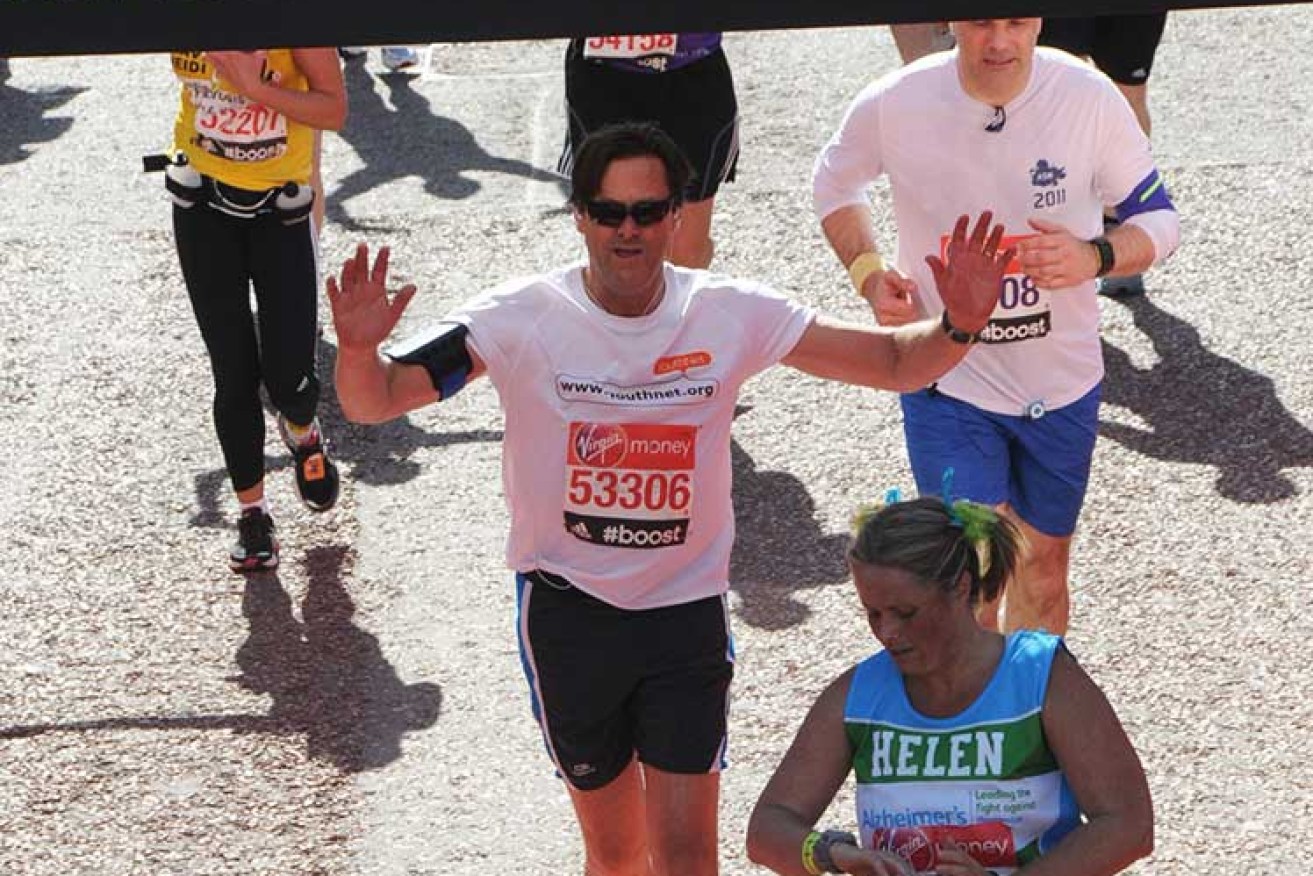Advisor: want to run a marathon? Here’s how

The author crosses the finish line.
So you want to run a marathon? Welcome to Nutsville.
There’s no other way to put it really. The idea of spending between four and six hours on your feet, running, walking and tottering along a strip of bitumen supposedly measuring 42.2 kilometres is, well, frankly crazy.
And yes, I meant it when I used the word supposedly because, as I found out, you will eventually travel much further than the official marathon length by the time you cross the line. The reason? The course is measured along the race line but because of the number of runners in these increasingly popular events it is impossible to follow it for the entire length. After I’d finished the London Marathon earlier this year I was shocked to find, from the GPS unit on my training watch, that I had actually run 44.3km. They don’t make allowances for that in the results, of course.

The author crosses the finish line.
But enough of the negatives. What you are planning to do is an experience you won’t easily forget. Just getting to the start line is an achievement in itself; not only a physical challenge but a psychological mountain. That’s why motivation is such a huge factor and why you need to crystalise your own reasons for attempting this before you begin the journey.
My experience began three years ago when I was captivated by the emotional finish to the 2010 event in the heart of London; not the elite runners but the thousands who made their way up Birdcage Walk to Buckingham Palace, crowds 10-deep, families crying and support teams yelling. It was inspiring but it seemed out of reach physically. I was reasonably fit for a man in his early 50s but mainly used to running on a gym treadmill for between 30 minutes and an hour.
Then my father, Arthur, passed away. He was a cross-country runner in his day and a man who was always one to refrain from talking about what he had done or was about to do, but simply got out there and did it. The two things gelled and as the London winter arrived in November 2013, I decided that I would attempt the improbable and signed up for the world’s biggest marathon, run in April.
So where should you begin?
Equipment
Don’t skimp on shoes because they are you saviour as your toes turn purple from pounding out the kilometres. Get the fitted properly and they should last until race day (Tip: never buy new shoes for the race itself).
Clothes
Simple. Shorts and a t-shirt. You don’t need to spend a bundle of money. Light and comfortable is best although it is important to dress appropriately for the weather, or changing weather given that at times you will be outside for more than three hours. Hats, rain jackets and even gloves can be important if you are training in the early morning, even in an Australian autumn or spring.
Equally, consider what you are wearing and carrying in hot or windy weather before you head out and not as an afterthought. Water is essential if you are running more than 90 minutes. Get used to drinking on the run because your body needs it!

Crossing Tower Bridge.
Technology
Get a training watch that suits your needs. Some people like more information, others less but it is important to track your improvements – and downtimes – as you progress. I would suggest that the more information the better. It gives you more options as your interest increases.
Training plan
There are many from which to choose, mostly available on the Internet and often free. It is a logical process so you can be confident that the one you choose will work if you follow them closely. The training is going to take between four and five months, so don’t be surprised if you find yourself adapting the schedule to suit your own needs during the period, given that you might have to deal with injury, illness or changing personal demands. I ended up writing my own plan as I learned more and decided to follow my instincts about my strengths and weaknesses.
Food
Eating is critical the closer you get to race day so start early. Food becomes fuel and, believe me, you will feel it on the day. So fill up on carbohydrates for energy before your training run (I loved a bowl of oats, sultanas and milk) and eat protein afterwards to aid repair of challenged muscles (I preferred an egg-white omelette with cheese or smoked salmon and a protein shake). Adopt a sensible, healthy eating plan. Do not starve yourself. This is not about weight loss but performance.
Training courses
You will need to map courses out – several if you can, not only because you will be increasing your distances but because you want to avoid becoming bored. Try to map runs that avoid too many road crossings and that you can always make your way back close to your starting position. Looping around public parks is a good idea and try to take in the views around your city or town as I did often running through central London. I did a run in Sydney recently and was reminded how gobsmackingly beautiful the city can be around the harbour.
Rest, recovery and routine
Rest is essential if you are going to avoid injury and allow your body to adapt naturally to your regime. You won’t be running every day; mix it up with cycling, cross training, weights and even yoga or stretch classes. Routine is important, if only to be your psychological guidance counselor. Many do their long run of the week on a Sunday because they have time and it happens to be the day when most marathons are run.
Above all, remember that this is a process that takes time, patience and determination. It is not a matter of how fast you can run but how far and how long you can go.
Count backwards from race day, one week at a time. The fourth Sunday is the day you should have run 35km, at least for the first time. The week before it should have been 32-33km and the week before that 29-31km etc.
Sounds a long way doesn’t it? IT IS!








